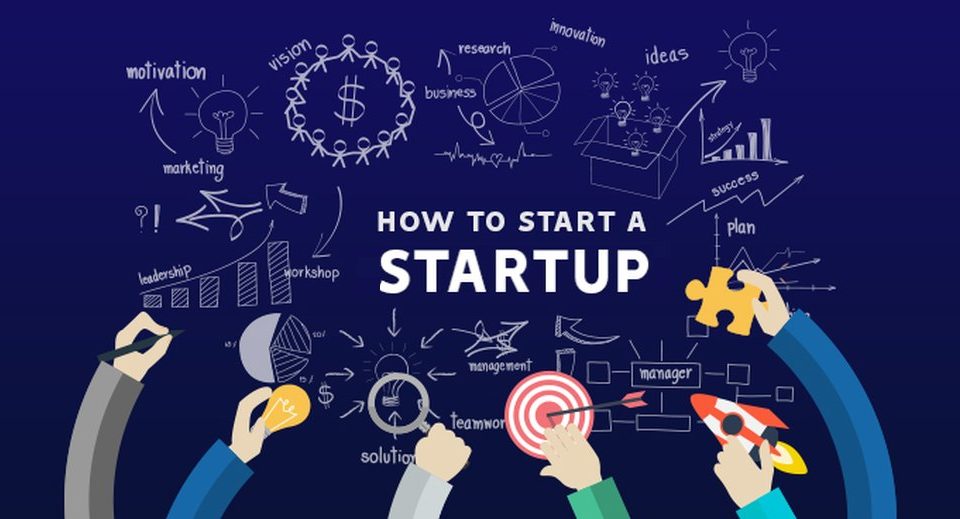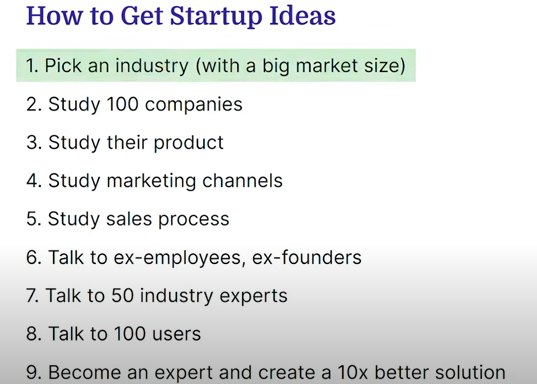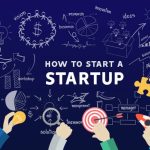How to Start A Startup: 10 Steps to Launch

In the fast-paced world of startups, innovation and disruption are the name of the game. These fledgling companies are fueled by a relentless ambition to revolutionize industries, whether by introducing something new or shaking up the status quo with a groundbreaking service. Often seen as pioneers, startups are at the forefront of driving change and challenging traditional norms in rapidly expanding markets.
According to a report by Microsoft, there are approximately 150 million startups globally, with 50 million new startups created each year. That breaks down to an eye-popping average of 137,000 startups launching every single day, showcasing the cutthroat competition in this arena and the daunting task faced by newcomers trying to find their place and thrive.
But the journey of launching a startup goes far beyond just having a brilliant idea and executing it. It demands meticulous planning, exhaustive research, and an unwavering commitment to constant improvement. Despite the allure of entrepreneurial success, the harsh truth is that a staggering 90% of startups fail within their first decade, underscoring the immense challenges they confront. This highlights that starting a startup isn’t merely about having a stroke of genius; it’s about meticulous planning, tireless research, and unshakeable dedication.
Navigating the turbulent waters of startup entrepreneurship can be a daunting endeavor, especially for first-time founders. The sheer magnitude of effort and dedication required, coupled with the sobering statistic that only about half of all businesses make it past the five-year mark, serves as a stark reminder of the inherent risks involved.
For those contemplating diving into the startup world, the process can indeed seem overwhelming, particularly for first-timers. The sheer volume of work and planning required, combined with the sobering fact that only about half of all businesses survive beyond five years, underscores the inherent risks. That’s precisely why a practical guide on navigating the startup landscape becomes indispensable.
While there’s no shortage of online articles promising easy steps to launch a million-dollar startup, the reality is far more nuanced. Building a successful startup transcends catchy headlines and superficial advice. True insights emerge from the experiences of successful founders who have confronted the trials of entrepreneurship head-on.
In contrast to typical “How To Start a Startup” articles, our aim with this guide is to offer practical insights gleaned from seasoned founders who’ve navigated the challenges of entrepreneurship firsthand. By tapping into their wisdom, aspiring startup creators can arm themselves with invaluable knowledge to turn their visionary concepts into flourishing ventures.
Drawing from real-world experience, this guide is rooted in the journey of Rob Liu, the founder and CEO of ContactOut. Having bootstrapped his tech startup to $10 million in annual recurring revenue (ARR), Liu’s insights serve as a blueprint for success. Through a detailed, step-by-step approach, readers gain firsthand insights into Liu’s journey, witnessing the precise strategies he employed to elevate his startup from humble beginnings to a revenue stream exceeding eight figures. So, let’s go.
How to Start a Startup in 6 Easy Steps
Starting your own startup can be daunting, but following these 9 practical steps can make the journey smoother. These steps are based on the LIFT framework coined by Liu, which stands for Learnings, Ideas, Tests, and Fast iterations. Essentially, it’s about quickly moving through a cycle of learning, brainstorming ideas, testing them out, and refining them based on what works.
The main aim here is to efficiently generate startup ideas. The quicker you can navigate through this cycle of brainstorming, testing, learning, and refining, the better your chances of launching a successful startup. Here’s a brief overview of each step to guide you through the process.
Identify Startup Ideas
The first crucial step is to pinpoint the right startup ideas. A good starting point is choosing an industry that aligns with your passion and has a sizable market. To do this effectively, it’s essential to dive into thorough research. This means studying various companies within the industry, analyzing their products, and connecting with industry experts.
“I’d start by picking an industry with a big market size that I’m passionate about. I’d find 100 companies, I’d study their sales, their product, their marketing. I’d talk to ex-employees, ex-founders, and industry experts, and I’ll talk to at least 100 users to really understand their problems. Through this process, I’ll be able to become an expert myself and use all this information to create a product and solution that is 10 times better than whatever else is already out.”
Immerse yourself in this process to uncover opportunities for innovative solutions that can outshine what’s currently available. Begin by selecting an industry you’re genuinely interested in and that has a substantial market. Dive deep into competitor analysis, examining their products, sales strategies, and marketing tactics. Engage with experts, former employees, and users to fully grasp the pain points in the industry, aiming to create a product or solution that far surpasses existing alternatives.
“I’d start by looking at 100 companies in my industry, recruiting by going to the Y Combinator startup directory or by searching recruiting on Crunchbase where there’s 2,000 companies, or by looking at the latest recruiting companies on Product Hunt. For every one of these companies, I’ll study their entire product, go through every screen and user flow, and assess their strengths and weaknesses. For example, I studied ZoomInfo and LuCIo. I’ll study their marketing tools like SEMrush, RocketReach, etc.”
Summary:
- Pick an Industry (with a big market size)
- Study 100 companies
- Study their products
- Study marketing channels
- Study sales processes
- Talk to ex-employees and ex-founders
- Talk to 50 industry experts
- Talk 100 users
- Become an expert and create a 10X better solution

Test and Validate Startup Ideas
Start by crafting ideas rooted in extensive research, with a focus on addressing specific problems. Create distinctive value propositions and sales strategies by studying competitors closely. Testing is key to minimizing risks and ensuring there’s real market demand before committing substantial resources. Don’t fall into the trap of developing a product without first confirming user interest through interviews or pre-sales initiatives.
“I’d start by asking ourselves what are the biggest risks and what is the fastest way to test and learn. A common mistake is to start building the product without validating whether users would buy it. For example, I spent one year building a time management tool called FocusAOT, only to find out that most people don’t want a tracker on their desktop that tracks their productivity and application usage by the minute.
They find this invasive. Google Glass is another example where Google spent a billion dollars in product development costs only to find out that people don’t want to wear robot glasses that make them look socially awkward. What you can quickly validate is, am I solving a real problem, and is my solution 10 times better than alternatives?
For example, at ContactOut, we spoke to 10 recruiters, and the consensus was that it’s difficult to get in touch with candidates, especially software engineers. Candidates don’t show up to interviews despite spending thousands of dollars on LinkedIn Recruiter and tens of thousands of dollars on recruiting fees. So is our solution 10 times better? LinkedIn has low response rates, and recruiters say that they prefer personal emails. But to be honest, we didn’t really get a clear answer here.”
Achieve Product Market Fit
Finding the perfect match between your product and the market is like discovering hidden treasure. It’s all about adapting and pivoting based on user feedback to meet their needs effectively. Take, for instance, Lumini, which evolved from simple customer support tools to full-scale automation, and Rer Health, which transformed from a holistic doctor marketplace to a specialized lab testing platform.
To hit that sweet spot of product-market fit, it’s crucial to listen to your users and adjust accordingly. Learning from those who’ve turned setbacks into triumphs highlights the importance of aligning your solutions with real-world demands.
Before diving headfirst into product development, it’s smart to gauge market interest through tactics like pre-launch sign-ups or strategic partnerships. Building anticipation through social media and content marketing can also help create buzz around your upcoming offering.
“Here’s some more examples. Lumini helps customer support reps save time. The first iteration was a simplified user interface for Zendesk that included keyboard shortcuts. The response to this was lukewarm. People were willing to try it, but it really wasn’t a painful enough problem. They then pivoted to a full customer support automation, where with the click of a button, a customer support rep can issue a refund.
And Lumini will go into Stripe and process the credit card refund, saving the customer support rep up to 15 minutes of time. There was an overwhelming response to this, where users signed up and paid thousands of dollars for the product before it was even built, which is complete night and day compared to the first response. And off of that, Lumini managed to raise $20 million in venture funding.”
Test Market Demand
Once you’ve nailed down your product-market fit, the journey doesn’t stop there. It’s essential to continuously test and validate your ideas to manage risks and ensure that your solutions are hitting the mark swiftly. In a video, Lui emphasizes the significance of grasping market demand before diving into product development. It’s all about gauging customer interest and their willingness to pay before pouring resources into building a product. Methods like pre-launch sign-ups, offering manual services, or even selling products that haven’t been fully developed can help gauge demand effectively.
Ensuring product-market fit is pivotal, as demonstrated by success stories like Lumini and Rer Health, who adjusted their offerings based on user feedback. Opting for a lean approach to product development—starting with the smallest but most valuable features—can help minimize resource allocation while enabling quick iterations and feedback loops.
“Before you build the product, will people buy it? So at ContactOut, we couldn’t actually get people to buy the product before we built it. But we did manage to cold email a lot of recruiters and have them sign up to a waitlist. And then we spent four weeks building a prototype. Here are some more examples. Ed Roller provides learning resources to high schools.
They sold to schools using a PowerPoint presentation and closed thousands of dollars in business before they had any learning resources created. Mint.com started as a personal finance blog, and they managed to sign up 100,000 users in six months just off of the content. Another good example is the makeup brand, Live Tinted, where they built an Instagram following of 250,000 before they launched any products, hence validating that they’re able to use social media as an acquisition channel.”
Build Minimum Viable Product (MVP)
Now that you’ve validated interest in your product, the next step is to put your efforts into crafting the smallest version of your product that still packs a punch and delivers real value to users quickly. Think about offering manual services or using white-labeled existing solutions to speed up the process and test the waters for demand. Listen closely to user feedback and keep an eye on market trends to prioritize which features to focus on, allowing you to iterate swiftly.
Here’s Liu’s insight on building your MVP:
“If it takes longer than four weeks, we want to break it down into smaller chunks, or we want to be very, very sure that we’ve proven demand enough to warrant the extra time investment. With ContactOut, we have a lot of features on our prospecting platform, like a search portal, email campaign tool, a Chrome extension for LinkedIn.
But the first version was simply a popup on top of LinkedIn that gave you an email address. We did spend a lot of time building our email database; however, in hindsight, that was a mistake. What we should have done is go to all our competitors, buy all their email data, aggregate it, and then resell it to customers, which is something that we could have done in two to four weeks.
Let’s look at how some other companies developed the minimum viable product, the smallest thing that they can build in under four weeks that provides the most value to users. One quick approach is to start by manually providing the service before automating it. Pilot, the biggest startup accounting firm in the US, started with one co-founder manually doing the bookkeeping.
From there, they learned about where the inefficiencies were in the accounting process and also what the customers wanted. Zenefits is a payment distribution service where companies can pay their suppliers and business partners in one go by uploading a spreadsheet. They also started manually by manually logging into hundreds of bank accounts to process payments. This way, they could start to provide the service immediately and validate demand while at the same time, they were building an automated payment system that would integrate with all the banks.”
Continue to Learn and Grow
Your startup journey does not end with delivering your product to the customers. You also need to encourage a work environment where learning is a constant journey. Teams should regularly share insights, set achievable goals, and be open to experimenting. Progress should be consistent, with lessons learned from both successes and setbacks helping to fine-tune business strategies. Liu emphasizes the importance of this continuous learning culture in startup growth. It involves gathering insights, brainstorming new ideas, and swiftly testing them out. This iterative method is what propels growth, as seen in ContactOut’s practice of setting weekly goals and experimenting.
Here’s how Liu explains it.
“Beyond continual learning, Liu stresses the significance of perseverance in startup triumphs. Success often demands a steadfast commitment over the long haul. Readers are reminded to stay dedicated, fueled by passion, and willing to iterate persistently in their pursuit of success. This echoes the wisdom of Steve Jobs, who emphasized the crucial role of perseverance in entrepreneurship.
Going back to our startup process, after we tested our business ideas, we’ll have new learnings about what worked and what didn’t work. And then we’ll form new ideas and test those. And we’ll just keep repeating the cycle of learnings, ideas, and fast tests. Tests should not take longer than one week to complete, and we should break things down into one-week experiments as much as possible. The goal of this is to learn something every week and improve our business ideas instead of being stuck for six months building a product only to find out afterwards that nobody wants it.
Here’s what this looks like at ContactOut. So every Monday, everybody at our company posts on a Slack channel called #goals, and they write about the goals that they accomplished last week, the tests that they ran, what did they learn, what can be improved, as well as the tests and goals that are scheduled for next week. Some of my recent goals included releasing an AI email writer feature that uses ChatGPT to automatically write personalized emails that are based on a person’s LinkedIn profile. Improving our sales operations, our lead assignment and lead scoring processes, and studying the AI courses from Stanford.”
Conclusion
In conclusion, the startup journey is characterized by relentless experimentation, adaptation, and perseverance. By following a structured process of ideation, validation, and iteration, entrepreneurs can increase their chances of success in the dynamic and competitive business landscape.
“To summarize, executing on a startup involves continuously iterating through the LIFT process: Learnings, Ideas, Fast tests. By learning from the market, generating ideas, and quickly testing them, you can efficiently discover what works and what doesn’t work, ultimately leading to the success of your startup. Remember to focus on building the minimum viable product quickly, validating demand before investing significant resources, and persevering through challenges with grit and determination. Keep learning, keep iterating, and keep pushing forward towards your startup goals. Good luck!”
Below is the video. Enjoy!




